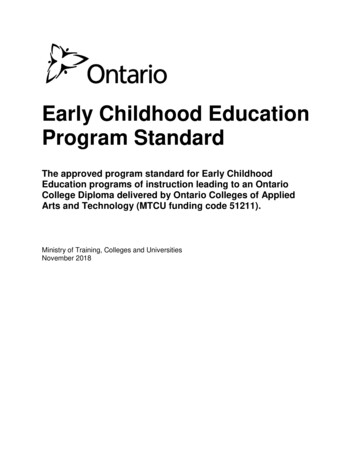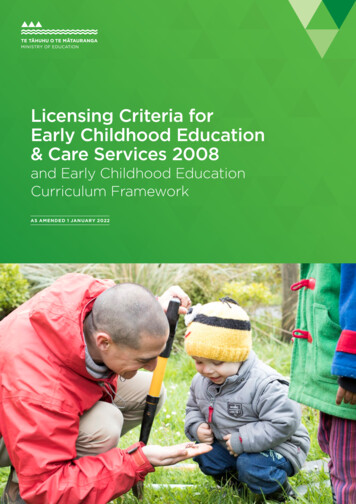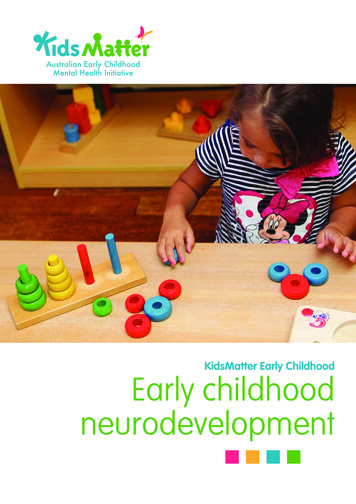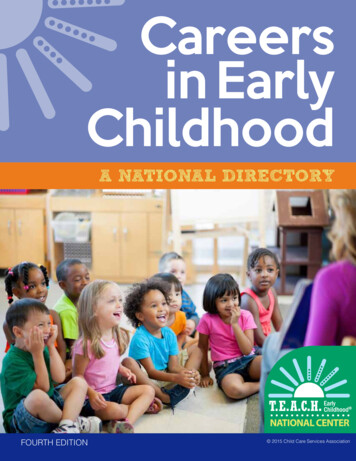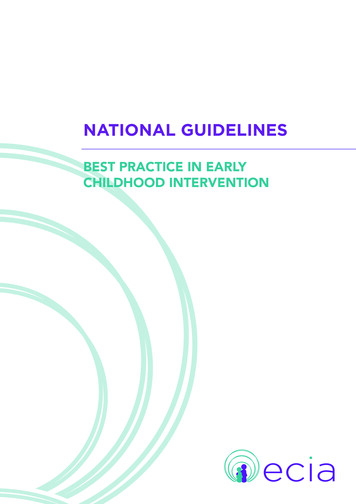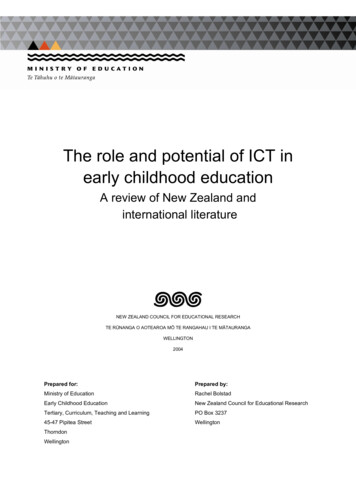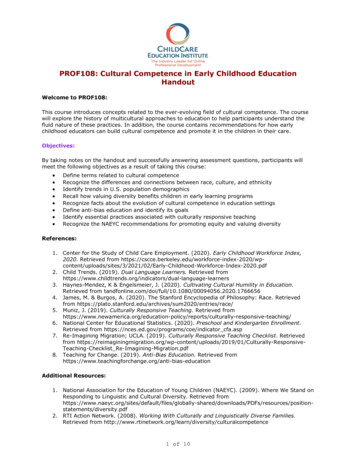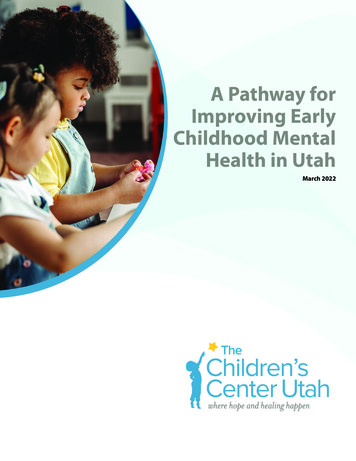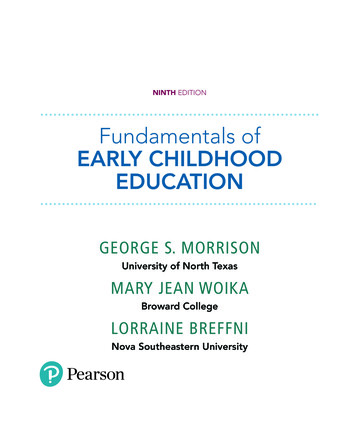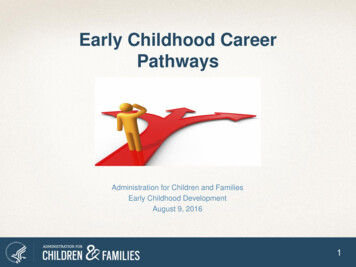
Transcription
Early Childhood CareerPathwaysAdministration for Children and FamiliesEarly Childhood DevelopmentAugust 9, 20161
VisionKnowledgeable, highly competent educators and programleadersWorkforce that is diverse in every setting, at every level ofprofessional education and roleSystem of professional development that is high-quality,accessible and affordable, and equitably supports educatorsand program leaders across all sectors2
2014-2015 DevelopmentsIOM study Transforming the Early Childhood WorkforceNSECE Center and home-based early childhood workforce dataWorkforce Innovation and Opportunities Act defines and highlightscareer pathwaysCCDBG Act requires states to develop a progression of professionaldevelopmentHead Start reaches 73 percent of teachers nationally with a BAdegree, exceeding the statutory requirement of 50 percent3
IOM: Transforming the Workforce forChildren Birth Through Age 8: A UnifyingFoundationDevelop and implement comprehensive pathways andmultiyear timelines at the individual, institutional, and policylevels for transitioning to a minimum bachelor’s degreequalification requirement, with specialized knowledge andcompetencies, for all lead educators working with childrenfrom birth through age 8.4
CCDBG Act of 2014Sec. 658E(c)(2)(G) Training and Professional Development(ii) Requirements.—The plan shall provide an assurancethat such training and professional development—(I) shall be conducted on an ongoing basis, provide for aprogression of professional development (which may includeencouraging the pursuit of postsecondary education), reflectcurrent research and best practices relating to the skillsnecessary for the child care workforce to meet thedevelopmental needs of participating children, and improvethe quality of, and stability within, the child care workforce;5
Head Start QualificationsMinimum requirement for teachers has increased level ofeducation in each reauthorization From CDA to Associate (1998) From Associate to Bachelor degree (2007 required 50%nationally to have a BA by 2013)In 2016, 73% of Head Start teachers have a BA degree6
WIOA Definition Career PathwayStrategy that combines: Stackable, portable credentialsreflecting increasing knowledge andcompetencies Supports for an individual toadvance on the pathway7
State Workforce StudiesEstablish baseline information and conduct regular updates– Cross-sector system elements– Coordinated data sources– Characteristics of individuals in the workforce– Diversity and equity– Financing system elements and individuals8
Shared Terminology Bureau of Labor Statistics OccupationalClassifications in Revision (2018)– ACF White Paper with recommendations forchanging classifications and definitions for earlychildhood educators and program leaders Glossaries developed by early childhood professionalassociations on training and adult education termsadopted by state PD systems9
ACF White Paper : ProposedRevisions to BLS10
Stackable, Portable Credentials From entry level basic health, safety and childdevelopment through industry-recognized certificatesand postsecondary degrees From high school-level course work to re-entry asworking educator re-entering the pathway for anothercredential or degree Recognized across early childhood sectors and settingsas educator moves from one job setting to another or toanother state11
Articulation Agreements and CreditTransfer Build a continuum of aligned adult learning Avoid coursework repetition by early childhood educators,saving time and finances Allow students to move among degrees and amonginstitutions Given the amount of professional development earned“on the job”, some states experimenting with credit forprior learning – assess competency and award collegecredit12
Career & Academic Advising Career awareness of the different types of roles/jobs inthe early childhood field Individual career and professional development plans,collaboratively developed with timelines for short and longterm Informed academic choices – credit bearing professionaldevelopment, degree choices and links to differentcertifications, institutions with articulation agreements,support for general education to enroll and complete BAprogram13
Access to PD and PostsecondaryEducationAccessibility of higher education – times of day, weekfor working educatorsQuality assurance for onsite and online courseworkand degreesLanguage and cultural diversity accessibilityFinancial aid for tuition, books, transportation and child careFinancial support for programs for paid professionaldevelopment release time, substitutes14
Conducive Workplace ConditionsState levelPromote workplace conditions in QRIS elementsEstablish and finance paid leave (sick leave,annual leave, family and medical leave) policiesProgram levelAssess workplace for conditions that foster professionalatmosphere– Paid professional development; release time;participation in Registered Apprenticeship, e.g.15
Align QRIS Systems Align professional qualifications in each step of theQRIS with the early childhood career pathway Engage career and academic advisors (career andtechnical programs, higher education) for supportingcareer development through the QRIS professionaldevelopment Implement higher reimbursement rates and otherincentives that recognize the cost of attracting andretaining educators and program directors with higherlevels of knowledge and skills16
Data Systems and EC Workforce Early Childhood Workforce Data – registries fordocumenting coursework, credentials, and approvedprofessional development providers Integrated Postsecondary Education Data Systems (U.S.Department of Education) - Institutional characteristics;enrollment; completions; graduation rates and outcomes;admissions; student financial aid; human resources;finance; and academic libraries.17
Linking Higher Credentials toFinancial IncentivesRaising standards needs to be linked to financial incentivesand compensation improvements– Linking career pathway to compensation scales– Scholarships for higher education linked tocompensation bonuses/rewards– Retention through higher compensation reflectingincreased level of credential or education attainment– Registered Apprenticeship job-embedded professionallearning with compensation improvement18
State Financing PD Systems19
Financing – New StudyNational Academies of Sciences, Engineering, and MedicineAn ad hoc committee will study how to fund early care andeducation for children from birth to kindergarten entry that isaccessible, affordable to families, and of high quality,including a well-qualified and adequately supportedworkforce consistent with the vision outlined in the reportTransforming the Workforce for Children Birth Through 8.20
ACF ResourcesEarly Educator Central https://earlyeducatorcentral.acf.hhs.gov/Early EdU www.earlyedalliance.orgNational Center on Early Childhood Development, Teaching & tem/ohs-tta/ncecdtl.htmlHHS/ED White Paper and state profiles - Low Compensation es/ecd/ece low compensation undermines quality report june 10 2016 508.pdfPolicy Statement on Early Childhood Career /ecd/career pathways policy final.pdf
New Mexico’s Efforts to Transform theEarly Care and Education WorkforceEarly Childhood Career Pathways Policy Statement:What Does This Mean for State and Local Programs?Katrina Montaño-WhiteEarly Childhood Quality Development AdministratorOffice of Child DevelopmentNew Mexico Children, Youth and Families Department22
History of New Mexico’s Articulation Agreement 1986The Department of Education eliminated several endorsements and among themwas early childhood. 1988A small group of advocates collaborated with key state legislators who championedearly childhood programs. 1991-92– Two boards were involved (Office of Child Development Board and theDepartment of Education) The first statewide early care and educationstakeholder meeting was held to establish a professional development system inNew Mexico. Development of Bachelor’s Level License23
History of New Mexico’s Articulation Agreement 1997 – PresentThe Kellogg grant reflected the commitment to improving the quality of earlycare and education for 3 years with two goals: Increasing access andmaking current and future programs more responsive to community needs.Articulation moving forward continued collaborationbetween all New Mexico Institutions of Higher EducationAt that time the primary task was successful articulation of the twoyear and four-year institutions through the development of commoncore content and the creation of a statewide common catalog ofcourses.24
History of New Mexico’s Articulation Agreement All programs across the state teach the same courses with the sametitles and course descriptions. Each faculty member can revise any syllabus to meet his/her own needsas long as there is no change in title, number of credits and coursedescription. The course objectives that match the core competencies and theidentified indicators in the Common Core Content must be met.The following seven competency areas were adopted by the Department ofEducation for the bachelors degree level in ECEI.II.III.IV.V.VI.VII.Child Growth, Development and LearningHealth, Safety and NutritionFamily and Community CollaborationDevelopmentally Appropriate ContentLearning Environment and Curriculum ImplementationAssessment of Children and ProgramsProfessionalism25
Workforce Development .Our CommitmentBecause the New Mexico Early Care, Education and FamilySupport Professional Development System encompasses allsystems serving children birth through third grade and theirfamilies, the term career lattice is the most appropriate way todescribe how individuals can move horizontally, vertically, and/ordiagonally within a single system, or across systems as positionsbecome available.The career lattice is designed so that each level fully articulates with thenext level.26
Workforce Development .Our Commitment Through the Race To the Top – Early Learning Challenge (RTTELC) grant we are providing opportunities for early childhoodstaff to gain a degree, and working with the 2 and 4 yearsColleges and Universities to make sure that students aregraduating with the knowledge and skills to work with infants,toddlers, preschoolers and families. We are also providing current teachers, home visitors andintervention staff with access to the most current information andtraining regarding the latest evidence based practices to promotethe development and learning of young children.27
Workforce Development .Our CommitmentT.E.A.C.H. Early Childhood SCHOLARSHIPS Providing for a cohort of New Mexico students to get Master’sdegrees in early childhood education at Erikson Institute in Chicago,Ill. Offering scholarships to groups of people for whom T.E.A.C.H. EarlyChildhood scholarships were previously unavailable — earlyinterventionists, college faculty, mentor/trainers, parent educatorsand home visitors. Supporting a cohort of PhD students at New Mexico StateUniversity, doctoral program that heavily emphasizes earlychildhood.28
Higher Education Taskforce In 1992 the first statewide early care and education stakeholdermeeting was held to establish a professional developmentsystem in New Mexico. In 2013 New Mexico Early Childhood Education HigherEducation Task Force became an official standing committee ofthe New Mexico Early Learning Advisory Council. Conduct Faculty Institutes specific to incorporating into all EarlyChildhood Education courses at the AA, BA and MA levels: New Mexico Early Learning Guidelines FOCUS TQRIS Full Participation Leadership29
New Approaches - Options State Based Team Partnership with Philanthropic Foundation –Thornburg FoundationWorking to improve early childhood outcomes in New Mexico bypromoting policies that improve the quality of the early childhoodsystem, increase access, and create a sustainably funded system. National Pilot Members– Santa Fe Community College– Western New Mexico University30
Thank You!Katrina Montano-WhiteKatrina.montanowhit@state.nm.usState of New MexicoOffice of Child DevelopmentChildren, Youth and Families Department31
Early Childhood Career Pathways PolicyStatement: What Does This Mean forState and Local Programs?Joellyn WhiteheadDepartment Director - Data & ResearchIllinois Network of Child Care Resource andReferral Agencies (INCCRRA)32
Professional Development SystemCost Analysis Tool Current Workforce Estimates– What qualifications does our workforce currentlyhave? Workforce Goals– What qualifications do we want the workforce tohave? What is the gap between current and goal? PD Initiative and PD System Investments– What PD and workforce supports are we currentlyfunding and how effective are they at closing the gap? Cost Estimates– What do we need to target to help meet the goals?33
Current Workforce Estimates At minimum, need total number of people in theworkforce Options to provide disaggregated data by:–––––SectorSettingRolesAges ServedEducational Milestones34
Pulling the Data Many potential sources including workforceregistry/data system, staffing surveys, licensingsystem, etc.– Registries meeting National Workforce RegistryAlliance Partnership Eligibility Review (PER)standards should have the data elements needed Flexibility of the tool is a major benefit – it canbe used to the level of detail you choose35
Using the Workforce EstimateResults Download data to Excel file View comparison reports with data fromNational Survey of Early Care and Education– Save as PDF– Download to Excel Data from workforce estimates used as thebasis for the next steps in the tool36
Workforce Goals View current percent of workforce at eacheducational milestone Establish targets (by percentage or number) forthe report year Provide specifics:– Starting from no education or from previouseducational level– Percent using various methods to achieve milestone(e.g., public and private IHE; clock hours vs. credithours; online vs. face to face)37
PD Initiative/System Investments Provide information about PD and workforceinitiatives in relation to support for identifiededucational milestones– Individual-level costs– Employer-level costs– PD System-level costs Can also provide information about investmentsthat support PD leadership staffing, workforcedata system, and other admin/infrastructurecosts38
Cost Estimates Reveal gaps and surplus to support establishedtargets for each educational milestone Estimates also provided for individual-level,employer-level, and system-level costs Test redistributing public funds and seematching private investments that would beneeded Download cost estimates to Excel to makeadditional tweaks39
Thank you!JWhitehead@inccrra.org https://www.inccrra.org/data-reports/reports40
Questions and AnswersThese slides will be posted on the ACF Website41
Early Childhood Quality Development Administrator Office of Child Development New Mexico Children, Youth and Families Department . 22 . History of New Mexico's Articulation Agreement 1986 . The Department of Education eliminated several endorsements and among them . was early childhood.
